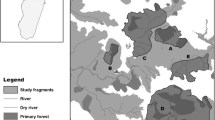Abstract
Advertisement calls are often important noninvasive tools for discriminating cryptic species and for assessing specific diversity and speciation patterns in nature. We investigated the contribution of these calls to uncover specific diversity in nocturnal Malagasy lemurs. We compared sexual advertisement and predator advertisement calls of two mouse lemur species, western gray and eastern rufous mouse lemurs (Microcebus murinus and M. rufus, respectively) living in two contrasting habitats (dry deciduous vs. rain forest), and analyzed them statistically. Both species emitted several highly variable whistle calls in the context of predator-avoidance. Intrapopulation variation was high and overlapped interspecific variation. Sexual advertisement calls, given in the mating context, displayed a totally distinct, species-specific acoustic structure. Whereas gray mouse lemurs produced rapidly multifrequency modulated, long trill calls, rufous mouse lemurs gave slowly frequency-modulated short chirp calls. Our results suggest specific status for gray and rufous mouse lemurs and indicate the importance of predation and social needs in shaping vocal communication.
Similar content being viewed by others
REFERENCES
Alcock, J. (1998). Animal Behavior. An Evolutionary Approach. Sinauer Associates, Sunderland.
Atsalis, S., Schmid, J. and Kappleler, P. M. (1996). Metrical comparisons of three species of mouse lemur. J. Human Evol. 31: 61–68.
Bearder, S. K., Honess, P. E., and Ambrose, L. (1995). Species diversity among galagos with special reference to mate recognition. In (Alterman. L., Doyle, G. A., and Izard, M.K., eds.), Creatures of the Dark, Plenum Press, New York and London, pp. 331–352.
Bradbury, J. W., and Vehrencamp, S. L. (1998). Principles of Animal Communication. Sinauer Associates, Sunderland.
Büsching, C. D., Heistermann, M., Hodges, J. K., and Zimmermann, E. (1998): Multimodal oestrus-advertisement in a small nocturnal prosimian, Microcebus murinus. Folia Primatol. 69: 295–308.
Daniel, J. C., and Blumstein, D. T. (1998). A test of the acoustic adaptation hypothesis in four species of marmots. Animal Behaviour 56: 1517–1528.
Fay, R. R. (1990). Hearing in Vertebrates: A Psychophysics Databook. Heffernan Press Inc., Worcester.
Fietz, J. (1998). Body mass in wild Microcebus murinus over the dry season. Folia Primatol. 69(suppl 1): 183–190.
Ganzhorn, J. U., Rakotosamimanana, B., Hannah, L., Hough, J., Iyer, L., Olivieri, S., Rajaobelina, S., Rodstrom, C., and Tilkin, G. (1997). Priorities for biodiversity conservation in Madagascar. Primate Report 48-1: 1–81.
Ganzhorn, J. U. (1988). Food partitioning among Malagasy primates. Oecologia 75: 436–445.
Goodman, S. M., O'Connor, S., Langrand, O. (1993). A review of predation on lemurs: Implications for the evolution of social behavior in small, nocturnal primates. In (Kappeler, P. K., and Ganzhorn, J. U., eds.), Lemur Social Systems and Their Ecological Basis, Plenum Press, New York, pp. 51–66.
Hafen, T. (1998). Dialekte bei Lemuren: Bioakustische, morphometrische und molekulargenetische Untersuchungen zur intraspezifischen Variabilität beim grauen Mausmaki (Microcebus murinus), Ph.D., University of Konstanz, Cuvillier Verlag Göttingen.
Hafen, T., Neveu, H., Rumpler, Y., Wilden, I., and Zimmermann, E. (1998). Acoustic dimorphism in the advertisement call of a morphologically and genetically homogenous population of wild grey mouse lemurs. Folia Primatol. 69: 342–356.
Hafen, T., and Zimmermann, E. (submitted). Colony-specific differences in the sexual advertisement call of the gray mouse lemur (Microcebus murinus).
Hansen, P. (1979). Vocal learning: its role in adapting sound structures to long-distance propagation, and a hypothesis on its evolution. Animal Behaviour 27: 1270–1271.
Hauser, M. D. (1996). Evolution of Communication, MIT Press, Cambridge.
Hunter, M. L., and Krebs, J. R. (1979). Geographical variation in the song of the great tit (Parus major) in relation to ecological factors. J. Animal Ecol. 48: 759–785.
Koeppl, J. W., Hoffmann, R. S., and Nadler, C. F. (1978). Pattern analysis of acoustical behavior in four species of ground squirrels. J. Mammalogy 59: 677–696.
Marler, P. (1955). Characteristics of some animal calls. Nature 176: 6–8.
Marler, P. (1973). A comparison of vocalizations of red-tailed monkeys and blue monkeys, Cercopithecus ascanius and C. mitis, in Uganda. Z. Tierpsychol. 33: 223–247.
Martin, P., and Bateson, P. (1993). Measuring Behaviour. Cambridge University Press, Cambridge.
Masters, J. C. (1991). Loud calls of Galago crassicaudatus and G. garnettii and their relation to habitat structure. Primates 32: 153–167.
Mayr, E. (1973). Grundlagen der Zoologischen Systematik. Parey, Hamburg.
Mittermeier, R. A., Tattersall, I., Konstant, W. R., Meyers, D. M., Mast, R. B. (1994). Lemurs of Madagascar. Conservation International, Washington.
Morton, E. S. (1975). Ecological sources of selection on avian sounds. American Naturalist 109: 17–34.
Niemitz, C. (1994). Vocal communication of two tarsier species (Tarsius bancanus and Tarsius spectrum). In (Niemitz, C., ed.), Biology of Tarsiers. Fischer, Stuttgart, pp. 129–141.
Nietsch, A., and Kopp, M.-L. (1998). Role of vocalization in species differentiation of Sulawesi tarsiers. Folia Primatol. 69(suppl 1): 371–378.
Nietsch, A. (1999). Duet vocalizations among different populations of Sulawesi tarsiers. Int. J. Primatol. 20: 567–583.
Nottebohm, F. (1975). Continental patterns of song variability in Zonotrichia capensis: Some possible ecological correlates. American Naturalist 109: 605–624.
Pastorini, J., Martin, R. D., Ehresmann, P., Zimmermann, E., and Forstner, M. R. J. (submitted). Molecular phylogeny of the lemur family Cheirogaleidae (Primates) based on mitochondrial DNA sequences.
Paterson, H. E. H. (1993). Evolution and the Recognition Concept of species. John Hopkins University Press, Baltimore.
Radespiel, U. (1998). Die Soziale Organisation des Grauen Mausmakis (Microcebus murinus, J. F. Miller 1777). Eine Freilandökologische und Laborexperimentelle Studie. Ph.D., University of Hannover, Verlag Dr. Köster, Berlin.
Radespiel, U., Cepok, S., Zietemann, V., and Zimmermann, E. (1998). Sex-specific usage patterns of sleeping sites in the grey mouse lemur. Am J Primatol. 4: 77–84.
Rakotoarison, N., Zimmermann, H., Zimmermann, E. (1997): First discovery of the hairyeared dwarf lemur (Allocebus trichotis) in a highland rain forest of eastern Madagascar. Folia Primatol. 68: 86–94.
Rothstein, S. I., and Fleischer, R. C. (1987). Vocal dialects and their possible relation to honest status signalling in the brown-headed cowbird. Condor 89: 1–23.
Rumpler, Y., Ganzhorn, J. U., Tomiuk, J., Leipold, M., and Warter, S. (1998). A cytogenetic study of Microcebus myoxinus. Folia Primatol. 69: 307–311.
Schmid, J., and Kappeler, P. M. (1994). Sympatric mouse lemurs (Microcebus spp.) in Western Madagascar. Folia Primatol. 63: 162–170.
Schwarz, E. (1931). A revision of the genera and species of Madagascar: Lemuridae. Proc. Zool. Soc. London 399–428.
Stanger, K. F. (1995). Vocalizations of some cheirogaleid prosimians evaluated in a phylogenetic context. In (Alterman, L., Doyle, G. A., Izard, M. K., eds.), Creatures of the Dark. Plenum Press, New York and London, pp. 353–376.
Tomiuk, J., Bachmann, L., Leipoldt, M., Atsalis, S., Kappeler, P. M., Schmid, J., and Ganzhorn, J. U. (1998). The impact of genetics on the conservation of Malagasy lemur species. Folia Primatol. 69(suppl 1): 121–126.
Wiley, R. H., and Richards, D. G. (1982). Adaptations for acoustic communication in birds: Sound transmission and signal detection. In (Kroodsma, D., Miller, E. H., Quellet, H., eds.), Acoustic Communication in Birds. Academic Press, New York, pp. 131–181.
Wrogemann, D., Radespiel, U., and Zimmermann, E. (in press). Comparison of reproductive characteristics of captive rufous (Microcebus rufus) and gray mouse lemurs (Microcebus murinus). Int. J. Primatol.
Zietemann, V. (1998): The vocal repertoire of the genus Microcebus. Abstract, IPS-Conference, Antananarivo.
Zimmermann, E. (1990). Differentiation of vocalizations in bushbabies (Galaginae) and the significance for assessing phylogenetic relationships. Z. Zool. Syst. Evol. 28: 217–239.
Zimmermann, E. (1995). Acoustic communication in nocturnal prosimians. In (Alterman, L., Doyle, G. A., and Izard, K., eds.), Creatures of the Dark: Biology of Nocturnal Prosimians. Plenum Press, New York and London, pp. 311–331.
Zimmermann, E. (1995). Loud calls in nocturnal prosimians: Structure, evolution and ontogeny. In (Zimmermann, E., Newman, J., and Jürgens, U., eds.), Current Topics in Primate Vocal Communication, Plenum Press, New York and London, pp. 47–72.
Zimmermann, E. (1996). Castration affects the emission of an ultrasonic vocalization in a nocturnal primate, the grey mouse lemur (Microcebus murinus). Physiol. Behav. 60: 693–697.
Zimmermann, E., Bearder, S. K., Doyle, G. A., and Andersson, A. (1988). Variations in vocal patterns of Senegal and South African lesser bushbabies and their implications for taxonomic relationships. Folia Primatol. 51: 87–105.
Zimmermann, E., and Lerch, C. (1993). The complex acoustic design of an advertisement call in male mouse lemurs (Microcebus murinus) and sources of its variation. Ethology 93: 211–224.
Zimmermann, E., Cepok, S., Rakotoarison, N., Zietemann, V., and Radespiel, U. (1998). Sympatric mouse lemurs (Microcebus spp.) in Northwest Madagascar: A new rufous mouse lemur species (Microcebus ravelobensis). Folia Primatol. 69: 106–114.
Author information
Authors and Affiliations
Rights and permissions
About this article
Cite this article
Zimmermann, E., Vorobieva, E., Wrogemann, D. et al. Use of Vocal Fingerprinting for Specific Discrimination of Gray (Microcebus murinus) and Rufous Mouse Lemurs (Microcebus rufus). International Journal of Primatology 21, 837–852 (2000). https://doi.org/10.1023/A:1005594625841
Issue Date:
DOI: https://doi.org/10.1023/A:1005594625841




